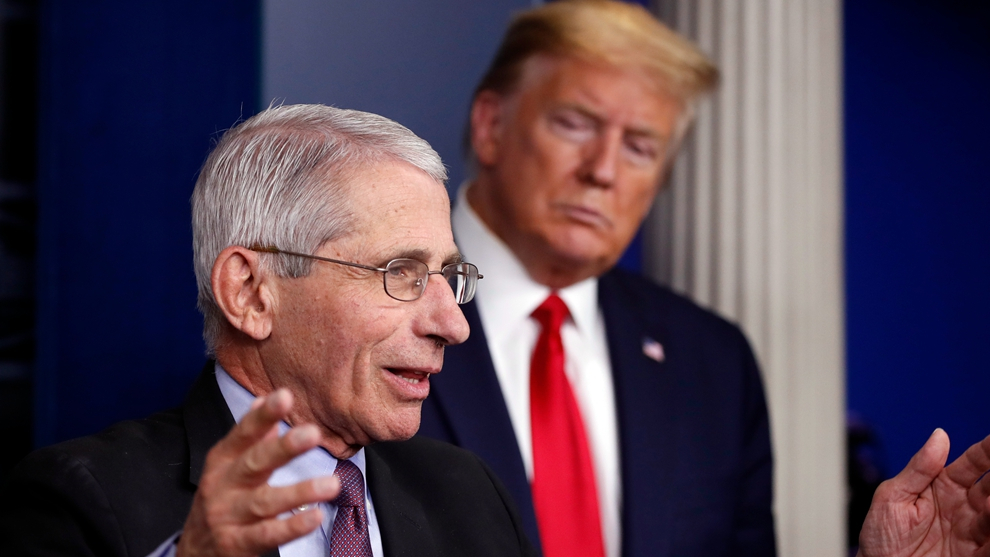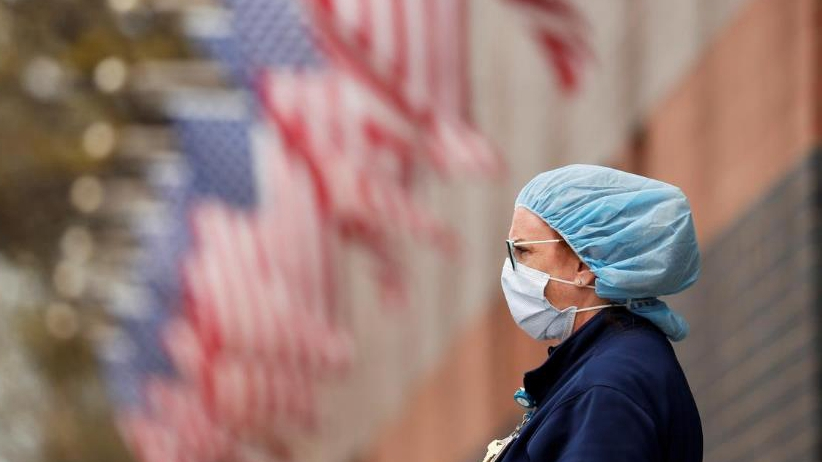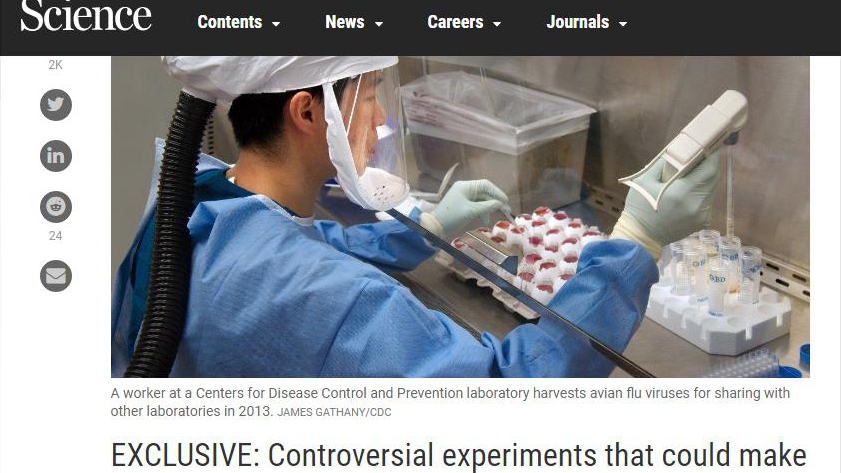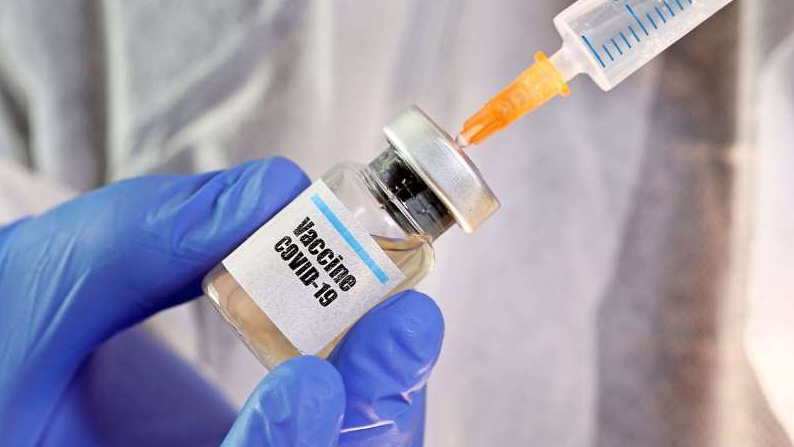10 conflicting things in U.S. government's handling of the pandemic
Editor's note: The U.S. has now more than one million confirmed cases and 60,057 deaths by April 30, both topping the other countries. In face of the frustrating number, the Trump administration occupied the media coverage for its blame on China, European Union and the WHO, and also its inaction in containing the disease spread within its territory. Based on U.S. media reports, here are 10 conflicting things in U.S. government's handling of the pandemic.

President Donald Trump watches as Dr. Anthony Fauci, director of the National Institute of Allergy and Infectious Diseases, speaks about the coronavirus in the White House, April 22, 2020. /AP
The fate of the controversial avian influenza virus modification experiment re-approved in 2019
The Science reported on February 8, 2019 that U.S. authorities had quietly approved an avian influenza virus modification experiment, which was on hold for more than four years. The research, aiming to transform the H5N1 virus to be more capable of infecting mammals, was controversial and considered extremely dangerous. It's believed that the modification may increase the risk of human-to-human transmission of the virus.
However, there are still no clear answers from the government about why it reapproved the experiment or any progress about the experiment.
The sudden halt and resumption of a research work at the U.S. Army Medical Research Institute of Infectious Diseases (USAMRIID)
USAMRIID, U.S. Army's primary institution and facility for biological research headquartered in Fort Detrick, Maryland, was ordered to halt the study of biological select agents and toxins in July, 2019.
In March, there was a petition on the White House website demanding the government tell why it ordered to shut down the institute.
And in April, the Global Biodefence reported that the facility has resumed full operation.
The sudden halt and resumption of the facility attract people's attention. There have been no specific explanations from the authority so far.

A nurse wearing personal protective equipment watches an ambulance driving away outside of Elmhurst Hospital during the ongoing outbreak of COVID-19 in the Queens borough of New York, April 20, 2020. /Reuters
Simulated pandemics, a coincidence?
According to New York Times, from January to August, 2019, the U.S. Department of Health and Human Services ran a scenario called "Crimson Contagion" that simulated the fictional outbreak involving a group of tourists visiting China. They then became infected and flew to various countries, including the United States.
Last October, a pandemic exercise named Event 201 was hosted by some U.S. organizations. The drill simulated a fictional virus called CAPS, which causes more severe symptoms than SARS and transmits via the respiratory route like the common flu, had caused a pandemic. Like COVID-19, there is no vaccine for CAPS.
The Event 201 is so similar to the COVID-19 pandemic. Is this just a coincidence? Based on the experiences or lessons from the simulated pandemics, why did the U.S. have no preventive methods at the early stage of the COVID-19 outbreak?
Early warnings of coronavirus pandemic fell on deaf ear
The American Broadcasting Corporation reported in April that in late November 2019, U.S. intelligence officials had warned the Defense Intelligence Agency, the Pentagon, and the White House that an infectious disease was sweeping through Wuhan, China.
Last November, the U.S. National Center for Medical Intelligence issued a report detailing the coronavirus pandemic, which was later identified as "COVID-19." Some analysts believed that the outbreak in Wuhan might have evolved into a catastrophic event.
And Washington Post reported that from January to February, U.S. President Donald Trump had received warnings from the U.S. intelligence agencies about the coronavirus.
However, it was not until March 13 that the U.S. government declared a national emergency, though there are so many early warnings.
Unclarified cases infected with COVID-19 among the reported influenza deaths
On February 21, Japanese Asahi Television reported that some of the 14,000 people reportedly killed by influenza in the U.S. might have died from coronavirus, which became a hot topic soon after.
The U.S. Centers for Disease Control and Prevention (CDC) reported at the end of February, there have been at least 32 million Americans have come down with influenza since this year's flu season began in late September.
On March 11, Robert Redfield, director of the U.S. CDC, admitted that some in the U.S. who were previously thought to have died of the flu may have been infected with coronavirus.
Among the reported influenza deaths in the U.S., how many cases were infected with COVID-19? Did the U.S. government cover up the spread of coronavirus with the flu? When will the U.S. government make public the samples of the U.S. influenza virus and its genome sequences, or allow experts from the WHO or the United Nations to do the sampling analysis?

A screenshot of the Science's report that U.S. authorities had quietly approved an avian influenza virus modification experiment, which was on hold for more than four years. /CGTN
The novel coronavirus' first emergence and community transmission
A 57-year-old woman from Santa Clara County of California died from COVID-19 on February 6, some 20 days earlier than the date the U.S. announced its first death caused by the virus, according to a report released in late April by local health authorities.
"We presume that each of them represents community transmission and that there was some significant level of virus circulating in our community in early February," The Los Angeles Times quoted Santa Clara County health officer Sara Cody in a piece saying.
"This is the evidence that the coronavirus was circulating in California as early as January or even earlier," County Executive Officer Jeffrey V. Smith claimed.
Gavin Newsom, the governor of California, has announced all counties in the state to review autopsies of suspected deaths from the coronavirus dating back to December 2019.
When did the novel coronavirus first emerge in the U.S.? Did community transmission of the coronavirus start before it was reported?
The first human testing of the COVID-19 vaccine in U.S.
The Wall Street Journal reports that the U.S. National Institutes of Health claimed on March 16 that Moderna Inc. has already started the first human testing experimental coronavirus vaccine against COVID-19.
Experts immediately raised questions about the speed of the vaccine development, saying that it would not be possible unless the U.S. had obtained the virus strains from very early on.
So how did the U.S. start the first human testing of the vaccine so soon? When and how did they get the virus strains?

The Wall Street Journal on March 16 reports that the first human testing of Moderna Inc.'s experimental vaccine against COVID-19 had already begun. /Reuters
U.S. government keep downplaying the coronavirus risks while its officials privately dumped millions in stock
According to The Washington Post, the U.S. Senate Intelligence Committee Chairman Richard Burr and his wife sold up to 1.7 million in 33 different stocks just one week before the market plunged.
Why did these officials at the Committee act so quickly while the government was continually understating the pandemic?
Why is the vital information kept confidential to the public while the government officials were taking advantage to practice insider-trading?
Public statement restrictions
According to the New York Times, the White House began to tighten its grip on the official release of all coronavirus-related information on February 27, a day after Vice President Mike Pence was appointed to lead the country's epidemic prevention and control efforts.
Top scientists and health officials, including leading infectious disease expert Anthony S. Fauci, have been instructed not to make public statements regarding COVID-19 before having consultation with Pence's office.
The placement of these restrictions certainly begs the question of why the United States, which claims free speech, would deny experts' rights to discuss the coronavirus in public and whether it intends to withhold facts. Is it because Washington is fearful of something?
U.S. overseas biological laboratories
Natalia Poklonskaya, deputy chairman of the State Duma Committee on Foreign Affairs, has proposed to examine the legitimacy of U.S. overseas biological laboratories, according to Sputnik news agency.
Russia's Foreign Ministry has also voiced concerns about U.S. moves to set up biological laboratories in former Soviet Union countries.
Grigory Trofimchuk, a Russian expert on internal affairs, foreign affairs and national defense, said none of these laboratories has disclosed any information regarding their research projects, but outbreaks of infectious diseases such as measles were detected near the site of these bio-labs.
It raises serious questions as to what research is being conducted by these labs and why the U.S. keeps tight-lipped about it.




Nessun commento:
Posta un commento